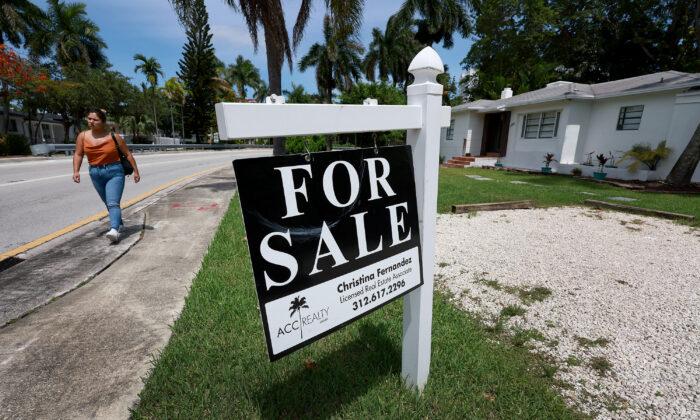Recession has been the buzzword in the real estate industry ever since mortgage interest rates started to climb toward 6 percent.
In the report, NAR Chief Economist Lawrence Yun says that we’re seeing a housing recession “in terms of declining home sales and home building.”
“However, it’s not a recession in home prices,” he adds, as inventory remains low and costs continue to rise, with almost 40 percent of homes still receiving the full list price.
According to NAR, the median existing home price for all housing types in July came in at $403,800, up 10.8 percent from July 2021. The report also notes that “this marks 125 consecutive months of year-over-year increases, the longest-running streak on record.”
Jessica Lautz, vice president of demographics and behavioral insights at NAR, told The Epoch Times that while housing sales are down, it’s still a seller’s market, and the real estate economy has no telltale signs of a recession like the one in 2008.

“First of all,“ Lautz said, ”there are much tighter lending standards now. We’re not seeing balloon loans or subprime lending. There’s also been an ‘unbuilding’ of homes in the United States for the past 15 years, and we’re short by about 5.5 million homes. Plus, you have to consider the new wave of millennials and other young adults currently seeking households.”
So, should potential homebuyers and sellers worry about what’s coming around the corner? Lautz says to be cautious, but also optimistic.
“We have seen a rise in mortgage interest rates, but there’s still some competition out there in the marketplace,” she said. “Things are beginning to stabilize. On average, we’re down from five offers on a home to three.”
However, first-time homebuyers may continue to be the most affected market.
“The current prices at the gas pump, grocery store, and other inflated goods will definitely have an impact on first-time homebuyers, making it harder for them to save money for a down payment,” Lautz said.

Recession in Home Construction
NAHB Chief Economist Robert Dietz echoes Lautz’s views about a possible full-blown housing recession.“While we are seeing a recession in terms of new home construction—which has been falling for the last five months—we’re not going to see the housing crisis of the Great Recession in 2008,” he told The Epoch Times. “Back then, there were substantial home price declines and millions of foreclosures. We’re just not seeing that now.”

Higher interest rates and escalating costs for lumber and construction materials are being blamed as part of the reason for the building slowdown in the single-family sector.
“That’s a symptom of the broader inflation issue, plus the disruption of supply chain as a result of COVID,” Dietz said.
The NAHB estimates the United States is falling short by more than a million homes, including single family, condominiums, and apartments. Year to date ending in June, single-family permits dropped in all four regions, with the Northeast reporting the sharpest decline of 11.5 percent. The South posted a small decline of just 0.8 percent. Over the past year, just 11 states experienced growth in single-family permits issued, with New Mexico recording the highest growth rate at 39 percent.
On the bright side, the markets leading the way for single-family home building include the Texas cities of Houston, Dallas, and Austin, as well as Phoenix and Atlanta.
“These areas have a larger inbound population, with a lot of younger homebuyers looking for more affordable options,” Dietz said.
He also noted that multi-family construction remains strong, as the demand for rental housing stays high. Currently, the number of multi-family units under construction is up almost 25 percent year over year. The New York-New Jersey area is still the top building market for apartments, followed closely by Dallas, Austin, Houston, and Seattle. In addition, construction of single-family built-for-rent homes surged during the second quarter of 2022, as housing affordability declined due to higher mortgage interest rates.
Looking ahead to 2023, Dietz believes that we could see more stability during the second half of next year.
Housing Market Already in Recession
A recent report from Scott Anderson, chief economist at Bank of the West, indicates that the housing market has already entered into a recession amid declining demand for mortgages, unsustainable property price growth, and deteriorating affordability.Citing a sharp plunge in existing home sales, Anderson believes the “housing market outlook continues to darken.”
“We are forecasting existing home sales to plunge 15.8 percent and 14.9 percent respectively 2022 and 2023—the largest home sales decline since 2007,“ Anderson writes in the report. ”The main causes of the steep drop is the worst housing affordability since 2006. Also contributing to the sharp slowdown is the uncertainty looming over the economic outlook.”
In addition, Anderson’s report comments that housing inventory shortage is no longer a problem and that new home inventories have increased to 10.9 months currently, from just six months in February.
Some Realtors Remain Upbeat
Despite gloomy forecasts from economists, some local realtors in the nation’s most popular markets see things differently.Andrea Crouch, president of Phoenix Realtors and owner of The Crouch Group, EXP Realty, says the Phoenix area is definitely still a “hot” market, even with the recent slowdowns in terms of listings and days on the market. With the median single-family home price of $450,000, prices have started to drop a bit, but only by about 5 percent.
“I think we’re starting to see a more balanced market here, and we don’t see that as a negative,” she told The Epoch Times. “It had been complete chaos for a while, and now buyers can actually have more than five minutes to think.”

Similar to the rest of the nation, rising interest rates have played a part in the normalizing of the Phoenix market.
“We tell buyers now that their purchase may be their forever home, but not their forever loan,” Crouch said. “They can always refinance when the rates go down.”
While Phoenix is listed as one of the top new housing construction areas in the country, Crouch notes that it has slowed down from previous years, with a lot fewer “spec” homes.
“They’re building, but they’re waiting until the buyer is ready to purchase,” she said.
Most of the influx to the area are people migrating from California, Montana, and Washington state. Many are remote employees with the flexibility to live and work wherever they want.
Looking ahead to the fall market, Crouch expects a “normal” season.
“You have to realize that about 70 percent of current realtors have not experienced a ‘normal’ market in a long time,” she said.
Antje Gehrken, president of the Chicago Association of Realtors and president and managing broker of A.R.E. Partners, acknowledges that the housing market has been getting a bit cooler, but that’s just compared to the past two years.
“The market during the pandemic was an anomaly, so you have to look back to 2019 in pre-pandemic times to make a comparison,” she told The Epoch Times. “You have to compare apples to apples.”
Inventory is still lower than normal in the Chicago area, and while some home prices have been sliding, Gehrken notes that if a home is priced correctly, it can still demand multiple offers and sell for more than the asking price.
“I think people have been a little reluctant to sell over the past couple of years because of the worry that they wouldn’t be able to find a new place,” she said.
With the current median sales price of $344,500 for a single-family home in the greater Chicago area and $355,000 for condos, local real estate professionals are hoping for a good fall market.
“There’s been a slight uptick in inventory, which can be seasonal, and in the winter, we always see less activity,” she said.
One trend that Gehrken has seen lately is the migration of homebuyers to nearby Indiana, which offers an easy commute to Chicago, and more affordable home prices.
Like her West Coast counterpart, Gehrken doesn’t see a real estate recession coming in the near future.
“The market is definitely stabilizing, and, as realtors, we’re used to that, and we have to plan for that,” she said.





